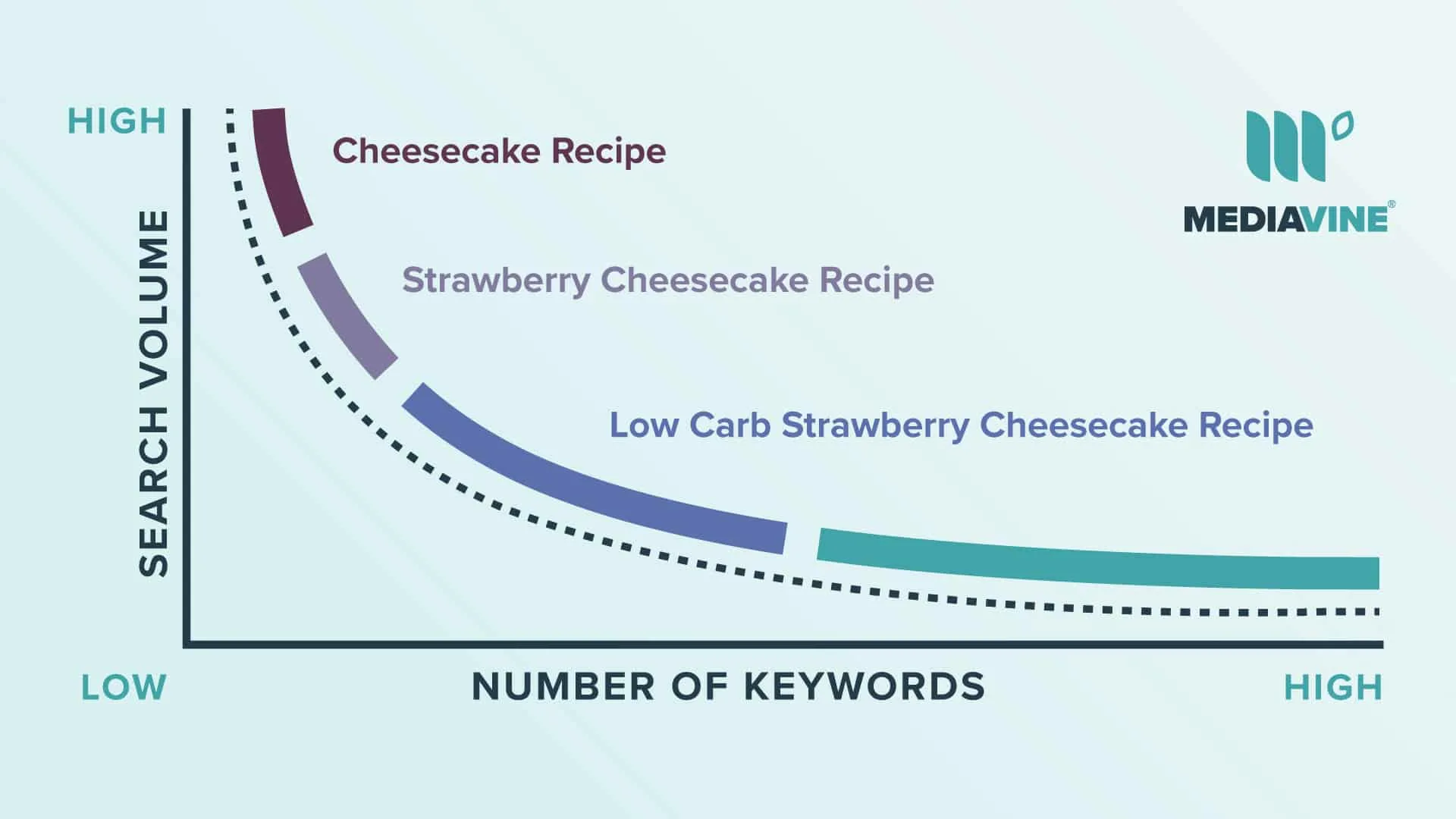Long Tail Keywords: A Long-Game Strategy For SEO Growth


Previously in our SEO series, we talked about what a keyword is, what it isn’t and how to approach them. Today, we’re diving further into this subject with a discussion of long tail keywords.
As their name implies, long tail keywords are the longer SEO keywords or keyphrases that you’re going to want to target as you grow your website.
Glad you asked. In statistics, the long tail refers to distributions with a heavy frequency of a small number of things and, by contrast, a lesser frequency of a greater number of things.
Think of the distribution of Google searches like the following graph. At the front end you see the biggest keywords, and on the right side are the long tail, or more specific searches.

The name is actually derived from how the data appears in visual form. You can see how the bigger terms form the “head” of the graph, while the many smaller terms end up forming a “long tail.”
There are fewer of these specific or long tail searches individually, but add them up and there are more searches for these smaller keywords and keyphrases overall than for the big prizes.
This same concept exists in broader business terms and is often attributed to the 2008 book, The Long Tail: Why the Future of Business is Selling Less of More by Chris Anderson.
In summary, for your website or your business (or both, if your website is your business), the same concept applies: Rather than focusing on the most competitive items, sell more of the less competitive.
Need proof that works? Look no further than Mediavine itself.
Call it power in long tail numbers. With 6,600 small-to-medium sized publishers, we serve more than 10 billion ad impressions per month, or more than nearly any legacy brand individually.
But back to the lecture at hand:
Simple as that. When it comes to search results, targeting the long tail works because the distribution of keywords and keyphrases online mirrors the above chart.
In fact, 70% of searches fall into what we describe as the long tail distribution.
That’s right, a significant majority of search traffic is actually made of up long tail keywords and not the select few biggest, or what we like to call “vanity” terms, you may covet a high ranking on.
Let’s go back to the “Low Carb Strawberry Cheesecake Recipe” example we used in our first article on keywords. According to keyword planning tools, it receives about 30 searches a month. Tiny.
By contrast, “Cheesecake Recipe” gets a whopping 201,000 queries. So clearly that’s what you should focus on, right?
No. First of all, our example is just one of hundreds, even thousands of long tail keywords related to cheesecake.
Describing your recipe alone, there might even be 20-30, and while we’ll generally recommend to focus on one keyword or phrase per post, your posts can and will rank for multiple long tail keywords.
Think of it this way: You’re not just going after “Low Carb Strawberry Cheesecake Recipe.” You’re also going after “Low Carb Cheesecake Recipe” (1,900 searches), “Strawberry Cheesecake Recipe” (8,100 searches) and maybe even things like “Keto Cheesecake Recipe” (9,900 searches).
You can see how the reach of these long tail keywords builds up almost as quickly as my appetite for cheesecake after writing that paragraph.
On the aggregate, the long tail far exceeds the big-ticket terms. Even better news? They’re a lot more winnable and more valuable to you.

The reason “Low Carb Strawberry Cheesecake Recipe” is a less-competitive search term than simply “Cheesecake Recipe” is because there are fewer posts about it and fewer searches for it.
To illustrate this, pretend we live in an overly-simplified (and sad) world where only three people have written cheesecake recipes on the entire Internet.
One of these bloggers has a blueberry cheesecake recipe, another a strawberry cheesecake recipe, and the third is some heathen who didn’t add any fruit.
In this scenario, “Cheesecake Recipe” is instantly three times as competitive as “Strawberry Cheesecake Recipe” recipe, since there are two other posts going after the same big term as you.
The real world, obviously, involves a lot more cheesecake. Not to mention a volume of traffic that blows our example away.
For “Low Carb Strawberry Cheesecake Recipe,” we’re talking 7.2 million results… A lot, to be sure, but nothing compared to 187 million for “Cheesecake Recipe.” That’s 26 times the competition.
Do yourself a favor and look at the websites winning the big terms compared to the long tail. We think you’ll quickly find that life will be a lot easier — and your efforts more fruitful — if you focus on the long tail.

We talked a lot about “user intent” in our last keyword post, but it’s important to reiterate:
Google has to parse hundreds of millions of pages to find the best result for a user. A one- or two-word search query makes it difficult, even impossible, to figure out what they want.
Using our original example, a user searching for simply “cheesecake” would receive 212 million Google results. But to what end?
Are they looking to package cheesecake? Look up the nutrition contents (not recommended)? Eat cheesecake in a restaurant? Make cheesecake at home? Google has no idea.
Fewer words mean less clarity as to what the user wants, and even if they make it to your page, they may not find what they want.
Having a user searching for keywords and phrases aligned with your exact post is a more valuable user.
That user is less likely to bounce, and more likely to stay engaged with your content, leading to higher RPMs, more newsletter signups, affiliate purchases — you name it. All because of the long tail.

That’s a discussion for another time. Using a keyword planning tool and optimizing for the long tail are subjects we’ll break down in greater detail in future articles.
For now, make sure you’re on the same page with what keywords to focus on and why. Then we can focus on which keywords to pick and how to optimize them.
Also, remember to use long tail keywords in your page titles, meta description, opening paragraphs, throughout your content, in anchor text for internal links and beyond.
Stay up to date with the latest from Mediavine
 Eric Hochberger
Eric Hochberger
Google recently announced that any publisher passing the new Page Experience algorithm will be considered for the top story carousels in Google News. This shift comes after years of Google …
 Eric Hochberger
Eric Hochberger
Whether it’s for SEO or monetization purposes, we always encourage publishers to update old content. We’ve discussed at length how specifically to update content to improve RPM and optimize for …
 Eric Hochberger
Eric Hochberger
Today on the Mediavine blog, we’re throwing it back to 2017, famously known to SEO experts across the web as the Year of the Parboil. It was never actually known …